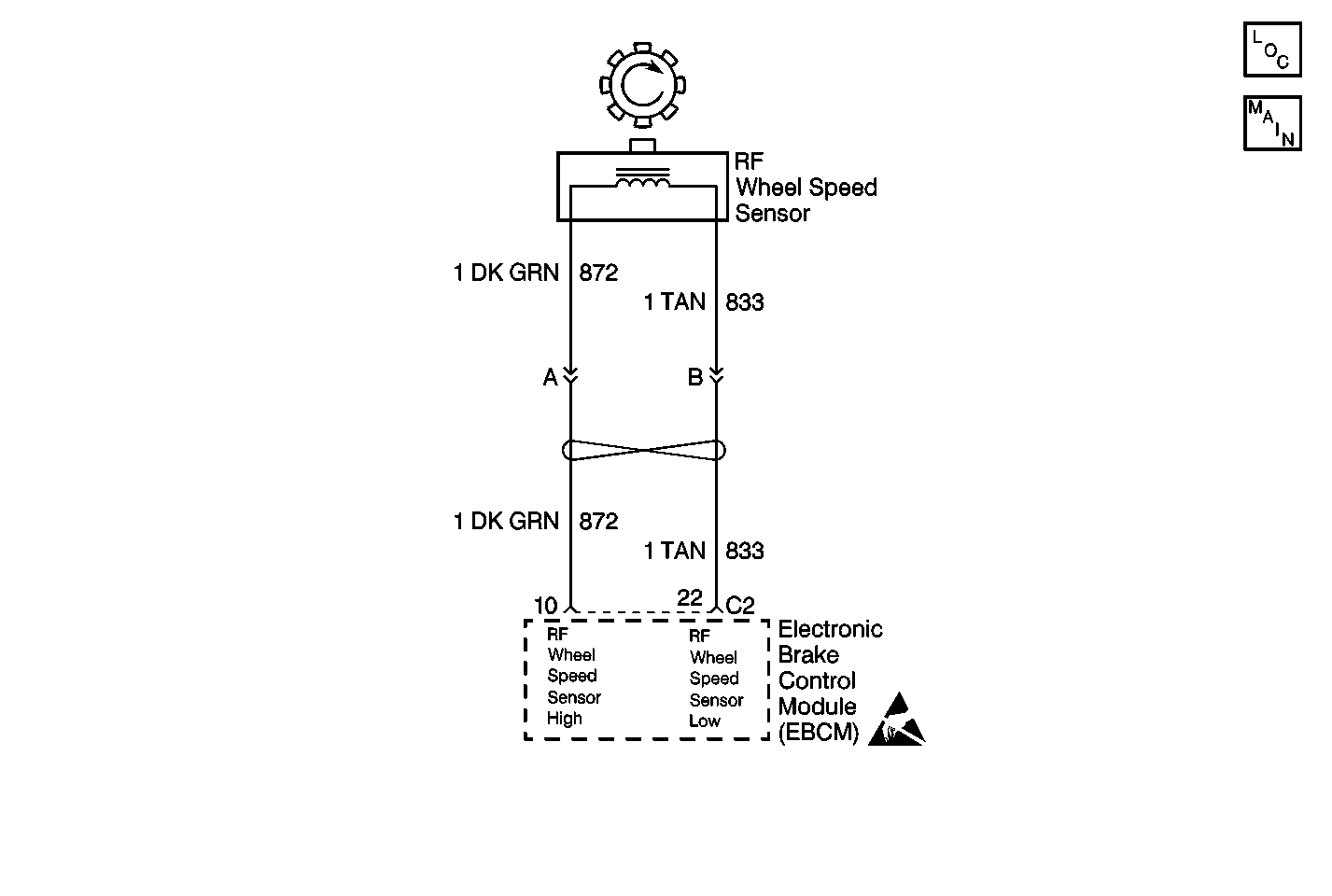
Circuit Description
The wheel speed sensor coil emits an electromagnetic field. A toothed ring on the wheel passes by the wheel speed sensor and disrupts this electromagnetic field. The disruption in the field causes the wheel speed sensor to produce a sinusoidal (AC) voltage signal. The frequency and amplitude of the sinusoidal (AC) voltage signal are proportional to the speed of the wheel. The amplitude of the wheel speed signal is also directly related to the distance between the wheel speed sensor coil and the toothed ring. This distance is referred to as the air gap.
Conditions for Setting the DTC
| • | The average wheel speed for all wheel speed signals is greater than 40 km/h (25 mph). |
| • | The average left front wheel speed is greater than 40 km/h (25 mph). |
| • | No speed signal input to the EBCM from the right front wheel speed sensor for 15ms. Anything which suddenly causes (intermittent) the right front wheel speed signal to drop to zero while the vehicle is moving greater than 40 km/h (25 mph). |
Action Taken When the DTC Sets
| • | The ABS indicator lamp turns on |
| • | The ABS disables |
DTC C0223 is an Ignition Latched DTC, which indicates that the above actions remain true until the ignition is turned to OFF (even if the cause of the DTC is intermittent).
Conditions for Clearing the DTC
| • | Repair the conditions responsible for setting the DTC |
| • | Use the Scan Tool Clear DTCs function |
Diagnostic Aids
Any of the following conditions may cause an intermittent malfunction:
| • | A poor connection |
| • | Wire insulation that is rubbed through |
| • | A wire breaks inside the insulation |
Thoroughly check any circuitry that is suspected of causing the intermittent complaint for the following conditions:
| • | Backed out terminals |
| • | Improper mating |
| • | Broken locks |
| • | Improperly formed or damaged terminals |
| • | Poor terminal to wiring connections |
| • | Physical damage to the wiring harness |
If the customer says that the ABS indicator lamp is on only during humid conditions such as rain, snow, or vehicle wash, then thoroughly inspect all wheel speed sensor circuits for signs of water intrusion. Use the following procedure:
- Spray the suspected area with a 5% salt water solution (two teaspoons of salt to 12 oz. of water)
- Drive the vehicle above 24 km/h (15 mph) for at least 30 seconds
If the DTC returns, replace the suspected harness.
When inspecting a wheel speed sensor, inspect the sensor terminals and the harness connector for corrosion. If evidence of corrosion exists, then replace the wheel speed sensor. Refer to Front Wheel Speed Sensor Replacement .
Test Description
The numbers below refer to the steps in the diagnostic table:
-
This step checks the resistance of the right front wheel speed sensor
-
This step checks the voltage output of the right front wheel speed sensor.
-
This step checks for a short in the wiring between the wheel speed sensor circuits.
-
This step checks for a short to ground in the wheel speed sensor circuits.
Step | Action | Value(s) | Yes | No |
|---|---|---|---|---|
1 | Was the Diagnostic System Check performed? | -- | Go to Step 2 | Go to Diagnostic System Check |
2 |
Are all the connections clean and tight? | -- | Go to Step 3 | Go to Step 6 |
Using a J 39200 , measure the resistance between terminals 10 and 22 of the 24-way EBCM harness connector. Is the resistance measurement within the specified range? | 1500-2500 ohms | Go to Step 5 | Go to Step 4 | |
Is the resistance measurement within the specified range? | 1500-2500 ohms | Go to Step 7 | Go to Step 8 | |
Are the wheel speed sensor and the tone wheel in good condition? | -- | Go to Diagnostic Aids | -- | |
Make the necessary repairs to the 24-way EBCM harness connector. Refer to Connector Repairs in Wiring Systems. Is the repair complete? | -- | Go to Diagnostic System Check | -- | |
7 | Repair the open or high resistance in CKT 833 or CKT 872. Refer to Wiring Repairs in Wiring Systems. Is the repair complete? | -- | Go to Diagnostic System Check | -- |
8 | Replace the wheel speed sensor. Refer to Front Wheel Speed Sensor Replacement . Is the repair complete? | -- | Go to Diagnostic System Check | -- |
